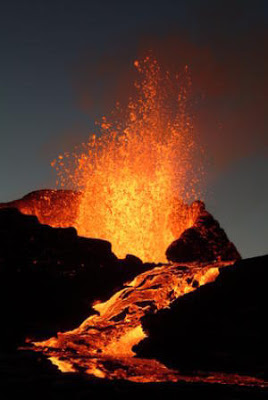
The “super-eruption” of a major volcanic system occurs about every 100,000 years and is considered one of the most catastrophic natural events on Earth, yet scientists have long been unsure about what triggers these violent explosions.
However, a new model presented this week by researchers at Oregon State University points to a combination of temperature influence and the geometrical configuration of the magma chamber as a potential cause for these super-eruptions.
Results of the research, which was funded by the National Science Foundation, were presented at the annual meeting of the Geological Society of America in Minneapolis, Minn.
Patricia “Trish” Gregg, a post-doctoral researcher at OSU and lead author on the modeling study, says the creation of a ductile halo of rock around the magma chamber allows the pressure to build over tens of thousands of years, resulting in extensive uplifting in the roof above the magma chamber. Eventually, faults from above trigger a collapse of the caldera and subsequent eruption.
“You can compare it to cracks forming on the top of baking bread as it expands,” said Gregg, a researcher in OSU’s College of Oceanic and Atmospheric Sciences. “As the magma chamber pressurizes at depth, cracks form at the surface to accommodate the doming and expansion. Eventually, the cracks grow in size and propagate downward toward the magma chamber.
“In the case of very large volcanoes, when the cracks penetrate deep enough, they can rupture the magma chamber wall and trigger roof collapse and eruption,” Gregg added.
The eruption of super-volcanoes dwarfs the eruptions of recent volcanoes and can trigger planetary climate change by inducing Ice Ages and other impacts. One such event was the Huckleberry Ridge eruption of present-day Yellowstone Park about two million years ago, which was more than 2,000 times larger than the 1980 eruption of Mount St. Helens in Washington.
“Short of a meteor impact, these super-eruptions are the worst environmental hazards our planet can face,” Gregg said. “Huge amounts of material are expelled, devastating the environment and creating a gas cloud that covers the globe for years.”
Previous modeling efforts have focused on an eruption trigger from within the magma chamber, which scientists thought would leave a visible trace in the form of a precursor eruption deposits, according to Shanaka “Shan” de Silva, an OSU geologist and co-author on the study. Yet there has been a distinct lack of physical evidence for a pre-cursor eruption at the site of these super-volcanoes.
The model suggests the reason there may be no precursor eruption is that the trigger comes from above, not from within, de Silva pointed out.
“Instead of taking the evidence in these eruptions at face value, most models have simply taken small historic eruptions and tried to scale the process up to super-volcanic proportions,” de Silva said. “Those of us who actually study these phenomena have known for a long time that these eruptions are not simply scaled-up Mt. Mazamas or Krakataus — the scaling is non-linear. The evidence is clear.”
It takes a “perfect storm” of conditions to grow an eruptible magma chamber of this size, Gregg says, which is one reason super-volcano eruptions have occurred infrequently throughout history. The magma reservoirs feeding the eruptions could be as large as 10,000- to 15,000-square cubic kilometers, and the chamber requires repeated intrusions of magma from below to heat the surrounding rock and make it malleable. It is that increase in ductility that allows the chamber to grow without magma evacuation in a more conventional manner.
When magma chambers are smaller, they may expel magma before maximum pressure is reached through frequent small eruptions.
The Yellowstone eruption is one of the largest super-volcano events in history and it has happened several times. Other super-volcano sites include Lake Toba in Sumatra, the central Andes Mountains, New Zealand and Japan.
Gregg said that despite its explosive history, it doesn’t appear that Yellowstone is primed for another super-eruption anytime soon, though the slow process of volcanic uplift is taking place every day.
“The uplift of the surface at Yellowstone right now is on the order of millimeters,” she explained. “When the Huckleberry Ridge eruption took place, the uplift of the whole Yellowstone region would have been hundreds of meters high, and perhaps as much as a kilometer.”
Other authors on the investigation include Erik Grosfils, of Pomona College, and John Parmigiani, an OSU engineer.
Note : The above story is reprinted from materials provided by Oregon State University.










